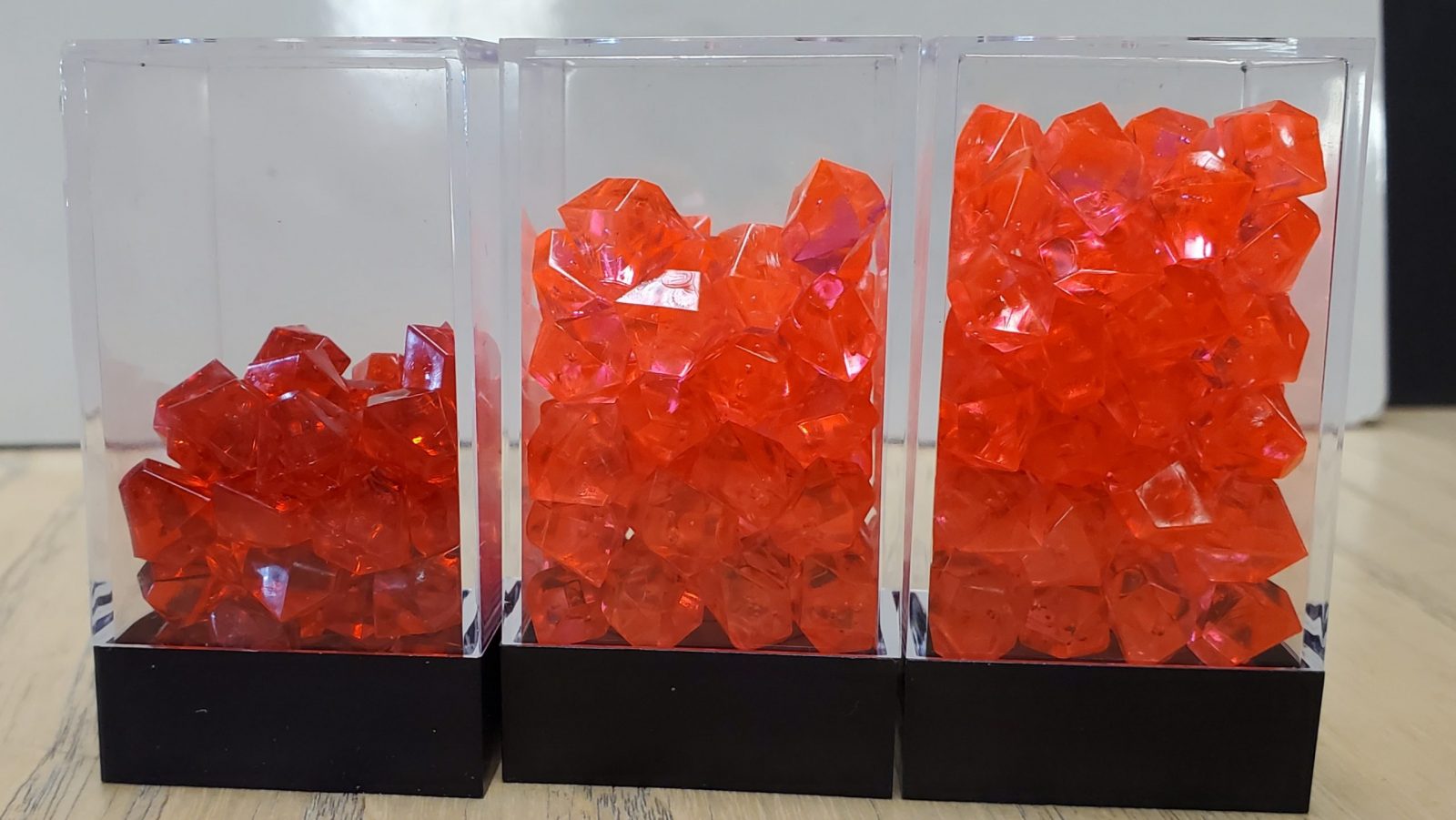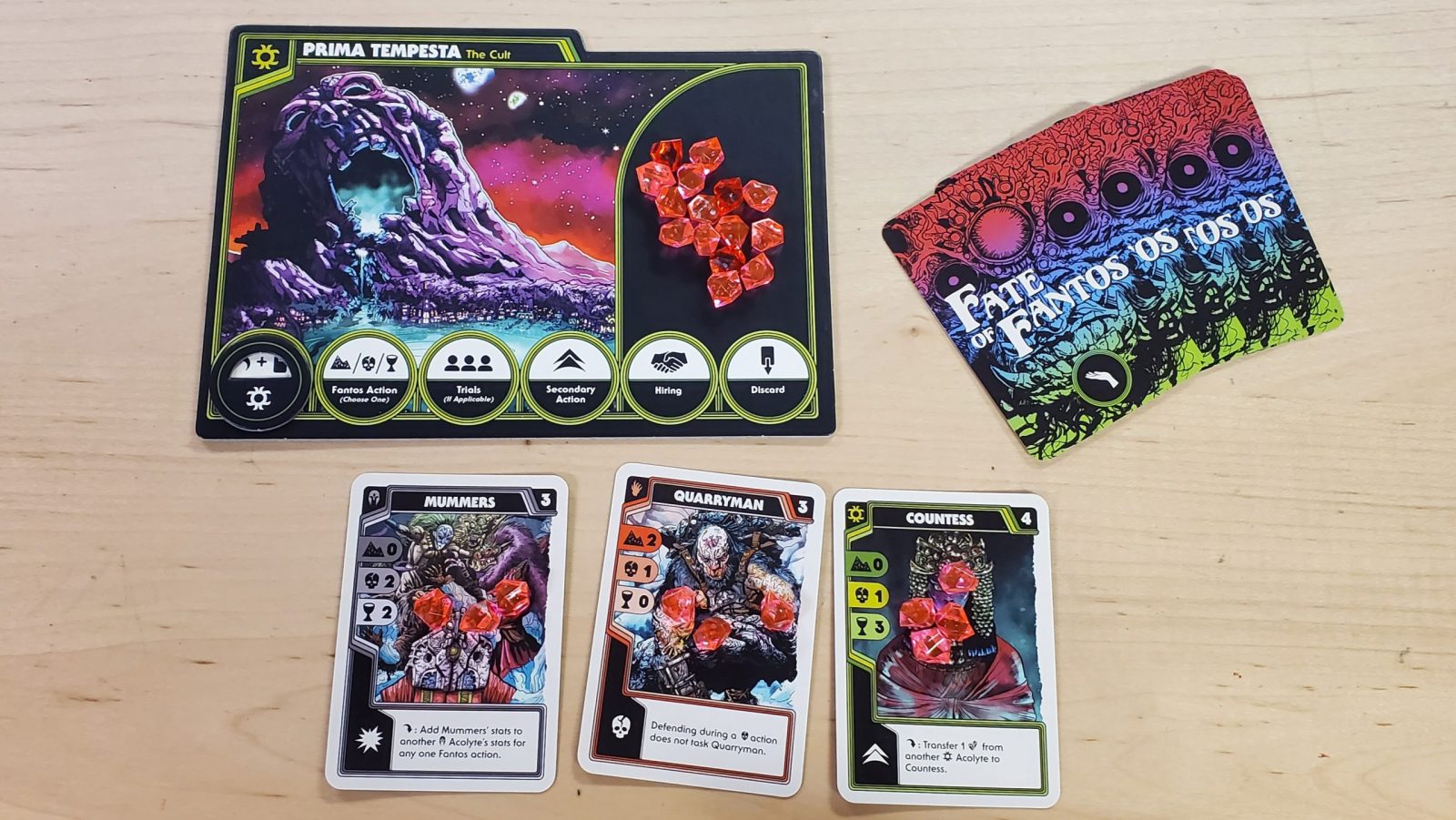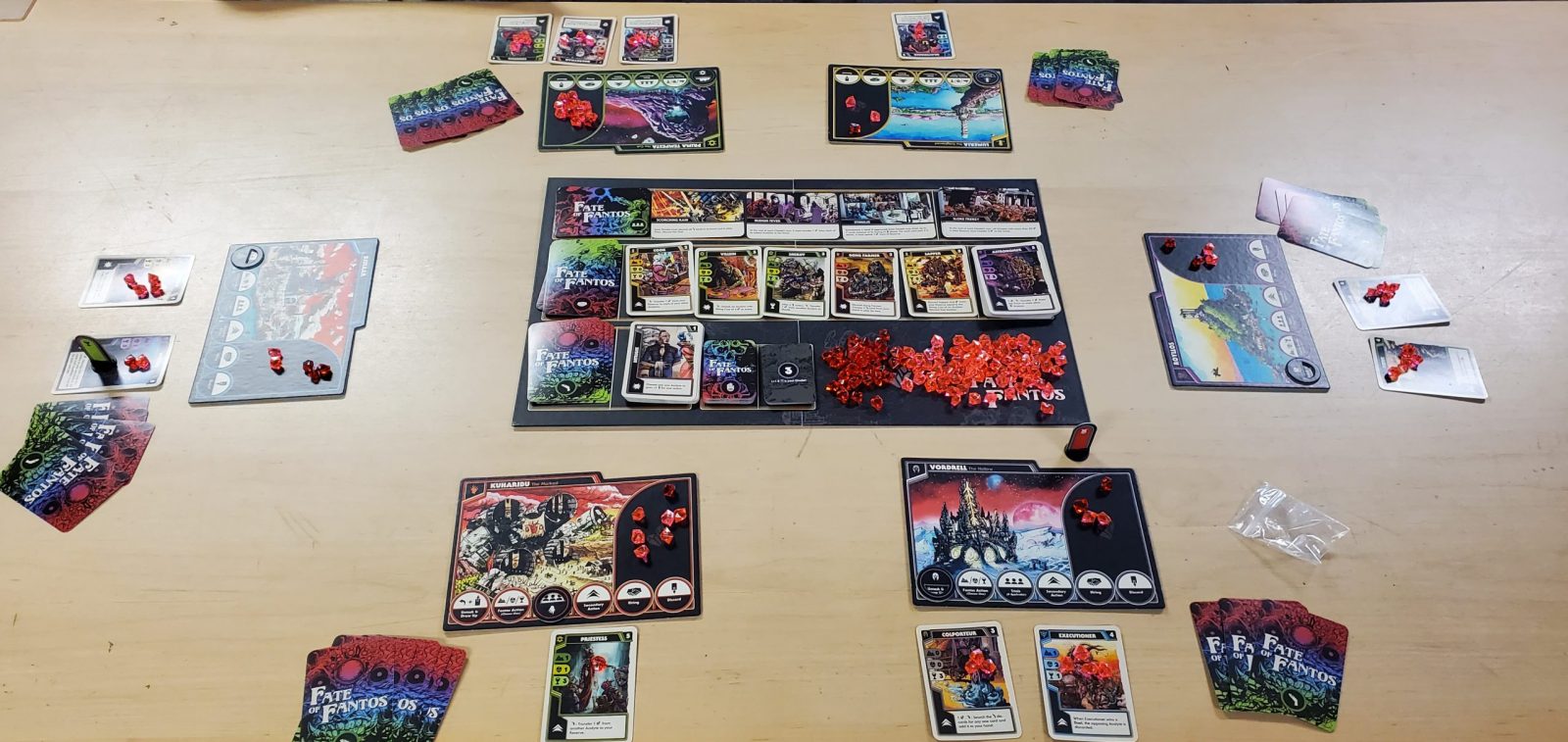
Fate of Fantos feels like a throwback to an older era – with all the good and ill that comes with that. The premise is kinda like “What if Dune got smashed together with Vampire: The Eternal Struggle?” – not only in theme, but also mechanics.
In Fate of Fantos, Fantos is a planet which is the sole source of a vital resource (Iridium). The desire to exploit Fantos has drawn massive numbers of people from all over the galaxy, which in turn has led to massive conflicts and ecological damage that threatens to destroy the planet itself. In response, the Cosmic Warden Zodraz has decreed that all but one political power (called Citadels) will be exiled from Fantos. In the game, you play as one of the six Citadels desperately vying to be the last Citadel standing, either because you have the most Iridium and gained Zodraz’s favor or because you are the last Citadel in play/that has any Iridium in reserve.
Visually, Fate of Fantos looks something that might have been at home in an early psychedelic heavy metal album cover or in an early Dungeons and Dragons or Warhammer game manual. If you dig the retro-aesthetic (and I do), the game is absolutely stunning. The artwork and general visual design nails what it’s going for. While pictures won’t do it justice, the one-value Iridium crystals have this wonderful practically glowing neon pink effect in person under direct light that is just perfect. (Pictures don’t do them justice.)

Red crystals on the left, pink crystals in the center and on the right.
Unfortunately, the retro-aesthetic is also a huge detriment to the game. The cards (especially the backs) for the different types of cards are almost identical, which lead to people I played with frequently drawing or discarding to the wrong piles. Additionally, cards’ colors and symbols are really important to the mechanics of the game. Regrettably, card colors are primarily lines around the edges of cards with fairly busy art in the middle, and the symbols on cards are small to tiny. Close up, this might not be so bad. Alas, this is a game for 3-6 players, and you will often have to determine what is going on in someone else’s play area from three or more feet away, and the tiny symbols and thin lines don’t cut it.


Somewhat similarly, while awesomely garish, the Iridium “crystal” tokens would probably have been better off represented by some sort of counter(s) – like d6s or d10s. As Iridium is not only the sole currency and resource to spend (and harvest and capture) in the game but also what makes up your and your Acolyte’s (characters) individual health pools, there are a lot of checks for Iridium values that need to be done throughout the game. Not only is constantly counting up your Iridium crystals a pain to constantly do regularly on your own assets, it’s practically impossible to do for someone else’s assets across the table without stopping play to ask them to tally up their values, and all that takes up time and slows down the game immensely. To make matters worse, in sub-optimal lighting it’s really hard to tell the red (5 value) crystals from the pink (1 value) crystals – especially if a player has mixed them together on their cards.
Last point on visual design elements, the game board itself is problematic. The layout of the board makes it easy to accidentally mix up discard piles with each other or the market, and it is set up in such a way that everyone kinda wants to be on the same side of the table. Not only would having 6 players all sit on the same side of the table be crowded, having players sit in a circular fashion is important to play. For example, Citadels can only attack people directly to their left (and sometimes right). Seating and orientation is not an issue unique to this game by any means, but it was still a major issue that led to slow down in many games I played. Frequently, we’d have to spin the game board around during play (possibly shifting the cards and mixing up the market and discard piles) or have someone get up and walk around to the other side of the table, with everyone then hiding their hands of cards. The game is already long and slow, and this design element just made an already difficult situation worse.

Mechanically, Fate of Fantos is… anachronistic. It’s been decades since I played Vampire: The Eternal Struggle/Jyhad (V:TES), the collectible card game (CCG) by Richard Garfield (of Magic: The Gathering fame) and based off the Vampire: The Masquerade roleplaying game. At least, Fate of Fantos feels a lot like I remember V:TES playing like. That is to say, despite having a fixed set of cards, the gameplay feels a lot like an early multiplayer CCG from the mid 90’s.
Fate of Fantos is chock to the gills with all sorts of symbols and game-specific terminology that one might expect from a CCG, but is likely absent in all but heavier board games. Phases in turns and other timing windows are extremely important. Virtually every action being performed by players can potentially be canceled (or piggybacked) at potentially any time by potentially anyone at the table. Having to track what everyone is doing in their own little play area in front of them from across the table because you may possibly want or need to jump in and interrupt what they are doing is not only hard (given the game’s visuals) but very time consuming (making Fate of Fantos a fairly long game). The rulebook even instructs that it’s a good idea to clearly communicate what each player is doing and give time for other players to respond.
Players also need a good understanding of what cards are in what decks. Like with CCGs, there are a lot of potential card interactions. Certain cards can cancel certain actions – including canceling the canceling of actions of other cards. Certain Citadels get discounts on certain cards. If certain cards show up at certain times, they might completely cripple or wipe out a player’s entire strategy and/or game state. If a player doesn’t know what special actions the various cards in play or in hand (or in the Trial deck) can perform and what the likelihood of them showing up might be, they can’t really make educated guesses about what’s happening in the game or what actions they should take.
Board games like Dune (1979), where predicting/guessing unknown cards in hand is critical, tend to require memorizing deck contents so players can know what cards are in the general pool and have a grasp on probability. However, the number, scope, and interaction of cards and their effects are generally smaller than in Fate of Fantos. CCGs like V:TES (1994), with card interaction on par with Fate of Fantos, tend to be highly competitive and are often “lifestyle” games with extensive metas (community predispositions) and deep time and money commitments. Players spend a lot of time and energy (and money) on such games, and often play few such games (maybe even just one). Players of such games generally have their own decks of cards that they know really well, and (given the competitive and deck building nature of such games) have a huge incentive in keeping up with what cards are in the game’s general pool and could be in opponents’ decks. I don’t think that’s going to be the situation for many people looking at a stand alone board game like Fate of Fantos. Even though there is a huge space for player interaction due to all the possible card interactions and timing windows, I think that this game needs more from players than most modern players would be willing to give it.
Also, while I love mean games, mean games are not as common in the modern era, and Fate of Fantos is a very mean game. The game is zero sum. There can be only one winner. There is player elimination. There is a set amount of Iridium in the game. Every action any player engages in takes directly or indirectly from other players. Iridium can be taken directly from other players (their Citadels’ reserves) or their Acolytes via War or Duels or during attempts to gain Zodraz’s favor (Tribute) or via card effects. Even harvesting Iridium from the supply/planet is zero sum, as the total amount of Iridium in the game is fixed. While I didn’t feel bad, I did play with a number of people – people who like meanness in their games – who indicated several times during play that they just felt bad when they took smart (and mean) actions they needed to in order to win.
Unlike a lot of modern games, Fate of Fantos is a 3-6 player game. There is no two player mode that one might expect in most CCGs let alone any solo mode like many people might expect in many modern games. Beyond that, I think the game is at it’s most technically/mechanically interesting at 6 players and… good luck finding 6 players who are going to be eager to sit down and play a long, slow, mean game that requires either a lot of upfront study or tons of repeated plays to get a good feel for all the potential mechanical interactions in order to play reasonably competitively and intelligently.
In my experience, you really need to have someone work as game administrator/judge to help keep the game moving smoothly and make sure everyone knows what’s going on and can interrupt actions if they want or need to, track Iridium totals, answer questions about discard pile or general deck contents or other status questions, advise new players, and resolve any odd or long chains of cause and effect. Given the higher target player count and general meanness of the game, having one of the players act as an administrator is often necessary but very suboptimal. Mean games give heavy incentives to misguide players, and mean games aren’t particularly fun if you can’t be mean. This results in whatever player that is acting as an administrator probably either not having a good time or not being fair – neither of which are great outcomes.
I don’t think Fate of Fantos is necessarily a bad game, and I do like it. I like games that are mean and reward learning and mastering their mechanics – and I think Fate of Fantos is a lot of fun with the right group of people. It’s just… a game very out of step with modern sensibilities, for all the good and bad that entails; and it’s a game that doesn’t necessarily outshine the last century of games that it seems inspired by. In particular (and this is pretty deal breaking), it definitely has some serious usability flaws that seem tied to its distinctive retro-aesthetic. You can get past some of that with sufficient familiarity, but not entirely. In the end, I think Fate of Fantos is the sort of game that really fits the mold of a game built for last century – when people might only play a few new games in any given year and might replay the same handful of their favorite games tens or even hundreds of times every year.
Fate of Fantos: The Iridium Wars
All Right
Fate of Fantos is a game out of time. It feels like a game designed last century - like a 70’s board game melded with a 90’s CCG - both aesthetically and mechanically. While there’s an enjoyable game here if you have the time, and right people, to reach it; it requires way more homework than most modern board games, it is mean in ways that haven’t been particularly common or broadly well thought of in decades, and it’s visual design (while stunning and evocative) works against the gameplay.
Pros
- Retro-art style is stunning to look at
- Lots of player and card interaction
- Mean
Cons
- Mean
- Long game with player elimination possible
- Minimum player count is three
- Card memorization and understanding timing windows are critical
- Retro-art style and components severely hamper gameplay
